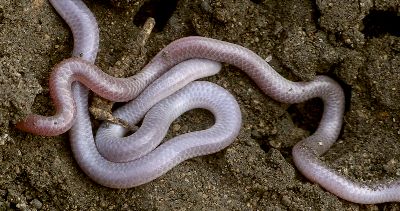
blind snakes (Leptotyphlops dulcis)
It is tempting to write back with a rather condescending remark like, "Look around you." But I know that this would not help anyone and these people are sincerely seeking a real answer. They are trying to do something that they have never before attempted and are often at a loss as to where to start. If a deadline is necessary to get someone to try hard to be observant and perhaps learn a little about their environment in the process,
 blind snakes (Leptotyphlops dulcis) |
This last idea, flipping stones over to see what lies beneath, is often completely overlooked. For some reason, although it is right under our feet, many people ignore the ground, and never think to get down on their knees and look closely. Some would even be embarrassed to do so. They especially don't want to reach into the dirt to dislodge something that might harbor an unknown creature underneath. Well, yes, there is that reservation. Just think of turning over a rock and finding a rattlesnake waiting to strike into your face. Just kidding. First of all, rocks are heavy. The average person cannot budge a stone that would be big enough to hide a snake den. Second, rattlesnakes would find a much better hiding place than under a single not-so-big rock. They usually require a roomier abode. Third, rattlesnakes are not burrowing snakes, another reason they would not be in the dirt right under a rock. If you were to lift a rock and find a rattlesnake, there is a good chance it would be dead because somebody smashed it with the very rock you were holding.
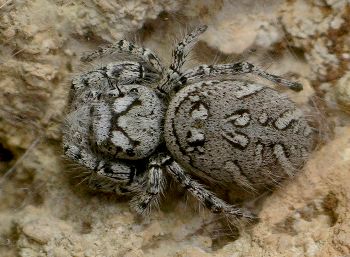 jumping spider (Phidippus mystaceus) hibernating |
Even though the rattlesnake scare is not real, there are reasons to be cautious. Never put your fingers into a crevasse or under a stone if you cannot see where they will end up. While large snakes are not likely, small creatures with fangs or stingers are definite possibilities. Fingers reaching into an animal's hiding place will trigger a defensive reaction against perceived predators, especially if the inhabitant is cornered and cannot retreat further, and their retaliation will probably hurt. Most rocks can be moved best by gripping a visible side and rolling, rather than reaching under and lifting.
Another issue to take into consideration is that the space under a rock is habitat, and rather specialized habitat to be exact. Once a rock is moved, that dark, humid, safe retreat is completely exposed and subsequently unsuitable for any animal that had previously found shelter there. It is only good stewardship to have the courtesy to replace the stone, as closely to how it was found, after you have had a look. While the animals beneath the rock may have fled in terror, restoring the habitat to previous conditions will mean that it will be available for future inhabitants.
As long as safety and environmental factors are addressed, there is nothing wrong with turning over rocks to discover what may be living beneath them. And there can be quite a number of possibilities.
The habitat under a rock can often be like a miniature cave. If a slab of limestone is lying on hard-packed clay, there might be no room between roof and substrate, and there are not going to be any interesting inhabitants. If, on the other hand, there are nooks and crannies in the soil below, these spaces are like rooms for rent, minus the landlord and payment. All it takes is for a creature to move in and they can call the cavity "home."
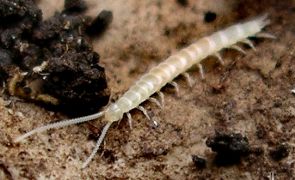 symphylan: an arthropod related to centipedes | 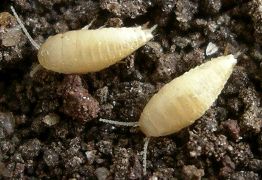 very tiny white silverfish |
It is easy to ignore rocks, and I often forget all about them as well. During spring and fall here in Texas, the weather is mild and the vegetation is host to myriad creatures, so I have to look no farther than the leaves and flowers. Bugs are flying all over and many animals are active right out in the open. But during the hot droughts of summer and the low temperatures of winter, most cold-blooded creatures take refuge. One hot summer day, I was walking on the edge of a large field where almost all the grass had turned brown. There were not even any grasshoppers to be found. I happened upon a single flat stone, only about a foot in diameter, and when I lifted it, there were several Blind Snakes underneath! These odd little reptiles look and live like earthworms, minus the slimy mucous.
Vertebrates are relatively rare finds, though. Much more common are spiders, beetles and other arthropods. During the winter, some adult spiders hibernate under rocks. Jumping spiders in the genus Phidippus are a good example. I have encountered large females in their hidden retreats on very cold days from November to March. These normally very active and wary spiders are immobilized by the low temperature and can be easily studied at this time. There are also a fair number of spiders that spend most of their lives under stones. When their home is exposed, they will usually run to the closest dark area, but sometimes they will freeze for a bit, allowing the curious naturalist to get a good look.
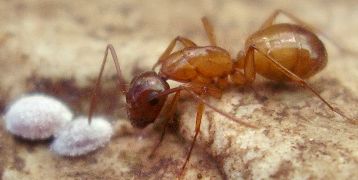 carpenter ant (Camponotus festinatus) with mealybugs |
The previous comment about the miniature cave description of habitat beneath a rock really seems appropriate pertaining to some arthropods. These are specialized soil dwellers that have almost no pigment and appear as white as true cave invertebrates. The most commonly encountered white creatures are usually long, thin centipedes, but sometimes other animals are found. Symphylans look similar to centipedes but are actually only distantly related and belong to a different class. Another odd little creature is a type of silverfish that is not much like the gray pests found in bathrooms and basements. These tiny white, teardrop shaped arthropods are easily seen against dark soil, but in their dark subterranean world, they have no need of camouflage pigment. There are members of this group of silverfish that are actually adapted to living in fire ant colonies, managing to somehow fool the ants into ignoring, instead of eating, them.
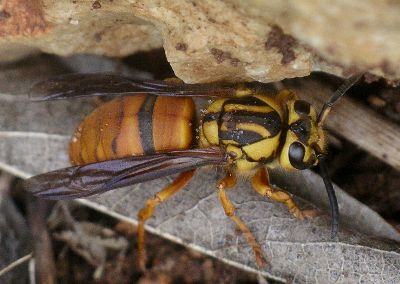 southern yellowjacket queen (Vespula squamosa) found hibernating under a rock |
A few other animals that are often found under stones include snails, slugs, land planarians, earthworms, scorpions, harvestmen (daddy long-legs), millipedes, pillbugs and sowbugs. One of the more interesting rock residents are queen yellowjackets. Just like the big female jumping spiders that wait out the winter under a snug stone, these large insects also find a cozy spot to hibernate. They will wait until the temperature rises enough in the spring for flight to be possible. Then the young queens will emerge, have a good meal of nectar, start building a nest, lay some eggs, and hunt for insects to feed to the first generation of workers. Once the queen has a mature brood, she can stay at the nest and concentrate on laying more eggs while her daughters go out and collect provisions for the whole colony. At the end of summer, a brood of queens and drones will be produced. After they mate, those future matriarchs will spend the winter under a rock.
Although the idiom "leave no stone unturned" is usually intended to mean something more general, like explore all possibilities, or exhaust all potential leads to solving a mystery, it doesn't hurt to take it more literally. Skip the rolling stones, as they will neither gather moss nor shelter fauna. When a long-undisturbed rock is lifted, though, one never knows just what might be found underneath.